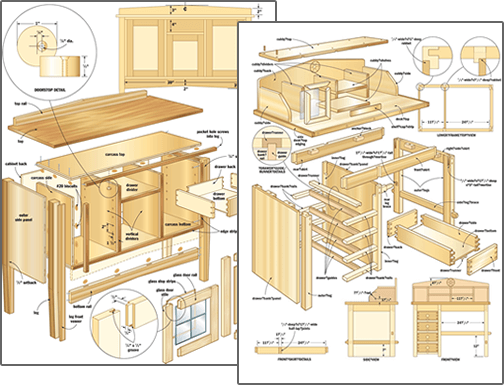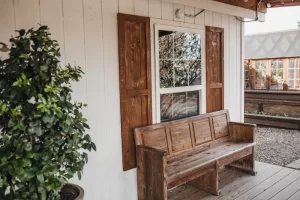50 FREE Woodworking Plans: A Comprehensive Guide
Introduction to Woodworking
Woodworking is an age-old craft that has captivated the imagination of artisans and creators for centuries. The art of transforming raw wood into beautiful and functional pieces is not only a satisfying hobby but also a gateway to unlocking your creativity. Whether you are a beginner or an experienced woodworker, this comprehensive guide will provide you with the tools, resources, and inspiration you need to dive into the world of woodworking.
Real quick, Ted is giving 50 of his woodworking plans absolutely FREE.
Benefits of Woodworking as a Creative Outlet
Woodworking offers a multitude of benefits as a creative outlet. Engaging in this craft can provide a sense of accomplishment and fulfillment, as you witness your ideas take shape and come to life. Working with wood allows you to unleash your imagination and create unique pieces that reflect your personal style and taste. Moreover, woodworking provides an opportunity for relaxation and stress relief, as you immerse yourself in the rhythmic motions of cutting, shaping, and sanding the wood.
Overview of Woodworking Plans and Their Importance
Woodworking plans are essential blueprints that guide you through the process of building various projects. These plans not only provide detailed instructions on the materials and tools you will need but also offer a step-by-step breakdown of the construction process. Having well-crafted woodworking plans at your disposal is crucial, as they ensure that your project progresses smoothly and effectively. They save you time, effort, and potential frustration by providing a clear roadmap to follow.
Understanding Different Types of Woodworking Plans
Woodworking plans come in various forms, catering to different skill levels and project types. One type of plan is the detailed project plan, which provides intricate instructions and measurements for building specific furniture or objects. Another type is the general plan, which outlines the basic steps and techniques for constructing common woodworking projects. Finally, there are thematic plans that focus on a specific style or design aesthetic, allowing you to explore different creative avenues.
Tips for Finding and Selecting the Right Woodworking Plans
Finding the right woodworking plans can seem like a daunting task, especially with the abundance of options available. However, with a few helpful tips, you can streamline your search and find plans that align with your skill level and interests. Start by browsing reputable woodworking websites, where you can find a vast array of plans ranging from beginner-friendly to advanced. Additionally, consider joining woodworking forums and communities, where experienced woodworkers often share plans and offer valuable advice.
50 FREE Woodworking Plans for All Skill Levels
To kickstart your woodworking journey, we have curated a collection of 50 FREE woodworking plans that cater to all skill levels. These plans encompass a wide range of projects, from small decorative items to large furniture pieces. Whether you are a novice looking to build your first project or a seasoned woodworker seeking new challenges, these plans will provide you with ample inspiration and guidance. From simple shelves and picture frames to intricate tables and cabinets, there is something for everyone in this comprehensive collection.
Real quick, Ted is giving 50 of his woodworking plans absolutely FREE.
Step-by-Step Guide to Starting Your Woodworking Project
Embarking on a woodworking project can be both exciting and intimidating. However, with a systematic approach and attention to detail, you can set yourself up for success. Follow this step-by-step guide to ensure a smooth and fulfilling woodworking experience.
Step 1: Define Your Project
Begin by clearly defining the project you want to undertake. Consider your skill level, available time, and the purpose or function of the finished piece. This will help you choose a project that aligns with your abilities and meets your needs.
Step 2: Gather Materials and Tools
Once you have chosen your project, make a comprehensive list of the materials and tools you will need. Research the specific type of wood required and ensure you have all the necessary tools and equipment to complete the project safely and effectively.
Step 3: Measure and Cut
Accurate measurements are crucial in woodworking. Take your time to measure and mark the wood precisely before making any cuts. Use appropriate saws and cutting techniques to achieve clean and precise results.
Step 4: Joinery and Assembly
Depending on your project, you may need to employ different joinery techniques such as mortise and tenon, dovetails, or pocket holes. Take your time to understand and master the appropriate joinery methods for your project, ensuring strong and secure connections.
Step 5: Sanding and Finishing
Once the main construction is complete, sand the wood surfaces to achieve a smooth and polished finish. Apply a suitable finish, such as varnish or stain, to protect the wood and enhance its natural beauty.
Step 6: Final Touches
Add any desired final touches, such as decorative elements or hardware, to complete your woodworking project. Take pride in your creation and appreciate the craftsmanship that went into bringing your vision to life.
(Continued in next section…)
Essential Tools and Materials for Woodworking
To embark on your woodworking journey, it is essential to have the right tools and materials at your disposal. While the specific tools and materials required may vary depending on the project, there are a few fundamental items that every woodworker should have in their toolkit.
Tools
- Circular saw – A versatile tool for making straight cuts in wood, perfect for both rough and precision work.
- Chisels – Essential for carving and shaping wood, chisels come in various sizes to accommodate different tasks.
- Hand plane – Used for smoothing and shaping wood surfaces, hand planes allow for precise control and create a smooth finish.
- Miter saw – Ideal for making accurate crosscuts and mitered angles, a miter saw is a must-have for any woodworker.
- Router – A versatile tool that can be used for cutting, shaping, and creating decorative edges on wood.
Materials
- Hardwood – Common hardwood varieties such as oak, maple, and walnut are popular choices for furniture and decorative projects.
- Softwood – Softwoods like pine, cedar, and spruce are often used for construction and outdoor projects due to their affordability and durability.
- Plywood – A versatile material composed of thin layers of wood glued together, plywood is commonly used for cabinets, shelving, and other structural components.
- Wood glue – An essential adhesive for joining wood pieces together, wood glue provides a strong and durable bond.
- Sandpaper – Used for smoothing and refining wood surfaces, sandpaper comes in various grits to achieve different levels of smoothness.
By having a well-equipped workshop and a variety of quality materials, you will be ready to tackle any woodworking project that comes your way.
Safety Precautions and Best Practices in Woodworking
Woodworking, like any craft, requires a level of caution and adherence to safety guidelines. Before you dive into your woodworking projects, familiarize yourself with these safety precautions and best practices to ensure a safe and enjoyable experience.
Protective Gear
Always wear appropriate protective gear, including safety glasses, a dust mask, and hearing protection. Woodworking involves sawing, sanding, and drilling, which can produce flying debris and loud noises. Protecting your eyes, respiratory system, and hearing is essential for maintaining your safety.
Tool Safety
Handle tools with care and always follow the manufacturer’s instructions. Keep your tools clean and well-maintained, and never force a tool beyond its capabilities. Ensure that blades and bits are sharp and in good condition to prevent accidents and achieve clean cuts.
Work Area Safety
Maintain a clean and organized work area to minimize the risk of accidents. Clear away clutter, ensure proper lighting, and secure your workpiece firmly before starting any cuts. Keep your workspace free from distractions to maintain focus and avoid potentially hazardous situations.
Electrical Safety
When working with power tools, be mindful of electrical safety. Inspect cords for damage before use and never overload electrical outlets. Use ground fault circuit interrupters (GFCIs) when working with power tools in wet or damp areas to prevent electrical shocks.
Fire Safety
Woodworking involves the use of heat sources such as sanders, routers, and finishing tools, which can pose a fire hazard. Keep a fire extinguisher nearby and be mindful of flammable materials in your workspace. Avoid excessive sawdust buildup, as it can be highly combustible.
By following these safety precautions and best practices, you can ensure a secure and worry-free woodworking experience.
(Continued in next section…)
Inspiration and Ideas for Customizing Your Woodworking Projects
Woodworking provides a unique opportunity to unleash your creativity and personalize your projects. Here are some ideas and sources of inspiration to help you customize your woodworking creations:
Nature-Inspired Designs
Take inspiration from the natural world and incorporate elements such as leaves, flowers, or animal motifs into your woodworking projects. Carve intricate patterns or use wood burning techniques to add a touch of nature’s beauty to your creations.
Mixed Materials
Experiment with combining wood with other materials such as metal, glass, or fabric to create unique and eye-catching designs. Incorporating different textures and elements can add visual interest and elevate your woodworking projects to the next level.
Custom Engravings and Inlays
Personalize your woodworking projects with custom engravings or inlays. Consider adding initials, names, or meaningful symbols to make your creations truly one-of-a-kind. Laser engraving and hand carving are popular techniques for achieving intricate and precise designs.
Upcycling and Repurposing
Give new life to old furniture or salvaged wood by upcycling and repurposing them into new creations. Not only does this reduce waste, but it also allows you to create unique and vintage-inspired pieces that tell a story.
Online Woodworking Communities
Engage with online woodworking communities to gain inspiration and share your work. Platforms such as Instagram and Pinterest are filled with woodworking enthusiasts who showcase their projects and offer valuable insights. Joining these communities can provide endless ideas and a sense of camaraderie with fellow woodworkers.
Showcasing Your Woodworking Creations Online
Once you have completed your woodworking projects, it’s time to showcase your creations to the world. Here are some tips for effectively showcasing your woodworking masterpieces online:
High-Quality Photography
Invest in good photography equipment or hire a professional photographer to capture your woodworking projects. High-quality photographs will showcase the details and craftsmanship of your work, making it more appealing to potential viewers and customers.
Engaging Descriptions
Accompany your photographs with engaging and descriptive captions. Describe the inspiration behind your project, the techniques used, and any interesting details. This will give viewers a deeper understanding and appreciation of your work.
Create a Portfolio Website
Consider creating a dedicated portfolio website to showcase your woodworking projects. A website allows you to organize and display your work in a professional and easily accessible manner. Include an about section, contact information, and links to your social media profiles.
Social Media Presence
Leverage social media platforms such as Instagram, Facebook, and Pinterest to reach a wider audience. Regularly post updates, behind-the-scenes glimpses, and finished project photos to keep your followers engaged and interested in your woodworking journey.
Collaborate and Network
Collaborate with other woodworkers, artisans, and influencers to expand your reach and gain exposure. Participate in woodworking challenges or join online woodworking groups to connect with like-minded individuals and learn from their experiences.
Conclusion: Embracing Your Creativity Through Woodworking
Woodworking is a timeless craft that allows you to tap into your creativity and create beautiful, functional pieces of art. By following this comprehensive guide, you now have the knowledge and resources to embark on your woodworking journey with confidence. Unlock your creativity, explore new techniques, and share your woodworking creations with the world. Embrace the joy of working with your hands and experience the fulfillment that comes from bringing your ideas to life through the art of woodworking.



